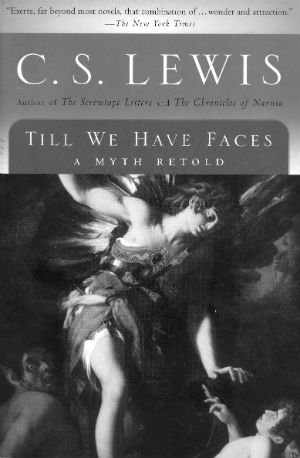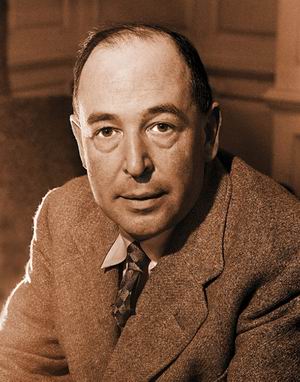‘Gaining a Face’ – C.S. Lewis’ Most Challenging Book
By Neil Earle

Recently our monthly Book Club at Cordova Library here in Memphis met to consider what is considered a “difficult” book – Till We Have Faces: A Myth Retold by the literary scholar and Christian apologist C.S. Lewis (1898-1963).
Basically Lewis retells the Myth of Psyche, Psyche the beautiful maiden loved by the god Cupid and whose life is immensely complicated as result. Along the way to unraveling the Myth as a moral tale of an often painful journey of self-discovery to achieve self-revelation, Lewis hits some of his familiar themes.
A Restless Longing
Even as a young girl Psyche experiences the Lewis motif of “immortal longing,” a psycho-spiritual quest beyond all the pleasures and advantages of this physical life, a gnawing hunger for something more. In Lewis’ retelling, Psyche’s sense of something tugging at her in the wind and sunshine, the colors and smells of the mountains behind her home (Think of Maria in The Sound of Music) fills her with a transcendent yearning that Lewis elsewhere simply calls Joy: “The sweetest thing in all my life has been the longing to reach the Mountain, to find the place where all the beauty came from,” Psyche tells her sister. She calls this the “longing for home” – a home which in Lewis’ belief system is a desire for a home we haven’t experienced of yet. “The Future calling to us from beyond history” (Moltmann). “He has placed eternity in men’s hearts” said the Preacher (Ecclesiastes 3:11).
Psyche’s Greek teacher had taught her how even some of their thinkers “have taught that death opens a door out of a little, dark room (that’s all the life we have known before it) into a great, real place where the sun shines and we shall meet.”
 C.S. Lewis
C.S. LewisA Mystical Calling
Lewis readers know how the author had experienced this ache of longing early in life when he gazed longingly at the Cave Hill Mountains behind his home in Belfast, something we can all relate to if we grew up in a “Walton’s Mountain” kind of scenery. Later in his book Mere Christianity Lewis solidified this almost mystical sense of a special longing into an almost dogmatic statement: “If I find in myself desires nothing in this world can satisfy, the only logical explanation is that I was made for another world.”
In 2013 Professors Don T. Williams and James Prothero, stalwarts of the C.S. Lewis Society of Southern California (CSLSC), shed more light on some of these themes in Gaining a Face: The Romanticism of C.S. Lewis, borrowing their title from Lewis’ retold tale of Cupid and Psyche.
In a report to CSLSC Prothero acknowledged his debt to a 1971 work by R.J. Reilly titled Romantic Religion: A Study of Barfield, Lewis, Williams and Tolkien. “Lewis has usually been seen as a Christian apologist or studied incessantly for his allusions to ‘Joy’ or ‘sehnsucht,’ but there was much more to him that that,” he said. “There is no doubt that Lewis was in the front ranks of the continuation of Romanticism that began in England with Wordsworth and Coleridge. Meredith Veldman’s 1994 work Fantasy, the Bomb and the Greening of England: Romantic protest, 1945-1980 underlines that claim.”
But what is Romanticism? And how can it be traced in Lewis?

The Romantic Journey
Prothero reminded the audience of the standard definitions, what he called “a rough group of concepts emerging in an organized way since 1789 with the French Revolution and the publishing of Wordsworth and Coleridge’s “Lyrical Ballads” in 1798 – a landmark in English Literature.”
Early Romanticism gave primary value to the Imagination over Reason, that was a critique of the more mechanistic and scientific concepts of the 1700s, of Newton’s “Clockwork Universe” and the Age of Reason. The roaring success of the Narnia series and the even earlier Space Trilogy attested to Lewis’ love of the fertile play of his imagination.
Secondly, there was Romanticism’s intrinsic interest in Nature, the environment, but meaning much more than that. Jim reminded us that Wordsworth and others saw nature as emitting a moral force, that “impulse from a primal wood.” Conservationism, the English love of gardens, he argued, reinforced this almost innate sense of something more to Nature than the useful or the ordinary. Lewis’ condemnation of the Un-Man killing the singing frogs in Perelandra plus his lifelong hatred of vivisection, showed a consistent respect for his fellow creatures, hence so many of them crowded into the Narnia narratives.
Romanticism was also noted for giving value to the Common Man and the will of the masses, an offshoot of 1776 and 1789. Lewis’ ability to speak to the common man surfaced in his 15-minute broadcasts over the BBC during the depths of World War Two, an intentional move by British elites to give a moral and humane underpinning to the struggle and its costs.
Fourthly, Romanticism sees a sense of balance between Good and Evil. Not a trivial point, Prothero emphasized, because “the 20th century concluded that Evil negates Good.” Lewis seems to channel both Augustine and Calvin in his view that God permits both Good and Evil in a sublime triumph of bringing Good out of Evil. Edmund’s treachery in the Narnia series sets up the dynamic whereby Aslan the Lion – the Christ figure in the Chronicles – has to sacrifice himself for the boy’s redemption. Yet Aslan emerges stronger and greater and more majestic by a “magic that was deeper than Narnia.” And Evil.
Lastly, the concern with Utopia. Romantics such as Shelley were enamored of the concepts of “the Beautiful” or “the Sublime,” of building heaven on earth. It is well-known that Lewis derived many of his views from the Late Victorian writer George MacDonald who acted as the transmitter of Wordworth for Lewis. Wordsworth of course is the preeminent poet of Nature in the English tradition. Alluding to Lewis’ early book The Discarded Image, Professor Prothero claimed “Lewis clearly liked the pre-industrial/medieval model better than today’s industrial outlook, that is, minus medieval astronomy.” Likewise his friend Tolkien lived in a small village then being absorbed into the approaching industrial city of Birmingham, “which perhaps gave rise to his deep feelings about Hobbitts and their idyllic life in the Shire.”
The Greater Narnia
However, Lewis was a Christian and thus more ambivalent to Nature than Wordsworth, claims Prothero. Some of the "Tintern Abbey Lines" (Wordsworth) stray into Pantheism. Jim argues that Lewis moved the Romantic preoccupation with Utopia into his articulation of Heaven which appears so often in his writings (most notably in “The Weight of Glory”). Thus Lewis had no doubt that the physical creation would share in the final Redemption (echoing St. Paul in Romans 8:20-21).
But in Lewis “Nature is only a preview,” Jim summarized, not the whole loaf. “Heaven for him involves the redeemed human body along with redeemed nature.” Wordsworth dwelt on the heavenly on earth but Lewis has his characters cleansed and re-clothed as they enter the Greater Narnia in The Last Battle, the goal that Aslan has been working towards in the series all along.
“MacDonald Christianized Wordsworth,” Dr. Prothero concluded, “and that gave Jack a strong lead towards his Romanticism. After all, what is Narnia but spectacular mountains, sea shores, rivers, woods and magnificent vistas?” The “green sward” of England as some call it.
Lessons Hard Won
In Till We Have Faces, the resolution Psyche’s sister Orual achieves at the end is a hard-won affirmation of life. All these experiences we pass through in this mortal coil circle us back to the Psyche Myth, in Lewis’s reconstruction. The main character in Till We Have Faces is Orual – ugly, unloved and bitter for most of the novel. The idealistic notions of Psyche’s early Romanticism can seem silly and futile to hard-edged realists such as Orual, the successful queen and administrator. She projects the love and longing all humans have and feel onto her sister but it becomes clear as we read that hers is a possessive love – “Smother Love,” not Mother Love. At one point she is willing to kill Psyche rather than let her be captured by her “imaginary” god-lover!
Foiled in this, Orual turns inwards and cover herself with a veil. This power of concentration on the tasks before her helps her become a successful queen and warrior but does nothing for the frustration and misery churning deep inside at what she sees as cold rejection by Psyche.
In Lewis’ story, it is Orual who writes the narrative which she summarizes as a long bitter complaint about how unfair the gods have been to her. Only when she comes to grasp some of her own coldness and manipulation of others through her symbolically taking off the veil does she achieve this deeper measure of understanding. Painful honesty about Self and motives is the way to maturity – almost a cliché yet vital if we are to finally “gain a face” in Prothero’s analysis. Then we see the god (and the Good) more clearly. Romantic hope and longing may seem nebulous and unrealistic until we are finally ready to view reality without the veil, possible an echo of St. Paul’s confidence of seeing God “face to face” (1 Corinthians 13:12). Then we are more able to enjoy life’s redeeming beauties and possibly fulfill that Longing we have always had but did not always recognize, a vision that got lost in the often hurtful minutiae of life.
Jim Prothero’s eye-opening title seems to hint at that conclusion.